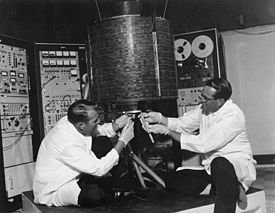- Intelsat I
-
Intelsat I - F1 
Ingenieure prüfen Intelsat 1Startdatum 6. April 1965, 23:47:50 UTC Trägerrakete Delta D Startplatz LC17A, Cape Caneveral NSSDC ID 1965-028A Startmasse 68 kg beim Start
34,5 kg im AllHersteller Hughes Modell HS301 Lebensdauer 3,5 Jahre Betreiber Intelsat Wiedergabeinformation Transponder 2 C-Band Transponder (4/6 GHz down-/uplink)
Transponderleistung 2 x 6 Watt
Bandbreite 2 x 25 MHz
Sonstiges Elektrische Leistung 40 Watt Position Erste Position 28° West Aktuelle Position 38° West (1966), heute driftend[1] Liste der geostationären Satelliten Intelsat I F1 („Early Bird“) war der erste kommerzielle geostationäre Fernsehsatellit weltweit und der erste der International Telecommunication Satellite (Intelsat).
Intelsat I wurde für die Communications Satellite Corporation (COMSAT) durch die Space and Communications Group der Hughes Aircraft Company, später Hughes Space and Communications Company und heute Teil der Boeing Satellite Systems auf Basis der Syncom-Satelliten der NASA gebaut und am 6. April 1965 mit einer Delta-D-Rakete vom Weltraumbahnhof Cape Canaveral in Florida ins All befördert.
Der Satellit wurde von der New York Times mangels eines griffigen Namens „Early Bird“ (Frühaufsteher) getauft. Er wurde von der US-Nachrichtengesellschaft Comsat erworben und Jahre später an die weltweit tätige Nachrichtensatellitenorganisation Intelsat weiter veräußert. Early Bird übertrug von seiner Position 35.800 km über dem Äquator am 28° westlichen Längengrad am 2. Mai 1965 die Fernsehunterhaltungssendung „Premiere im Weltraum“ auf beide Seiten des Atlantiks. Am 28. Juni 1965 nahm er offiziell seinen kommerziellen Dienst auf. Trotz der geplanten Lebensdauer von nur 18 Monaten funktionierte er mehr als drei Jahre und wurde erst im Januar 1969 abgeschaltet, jedoch im Juni 1969 für die Mission Apollo 11 wieder für zwei Monate reaktiviert. Viele Jahre später (1984) wurde er zum zwanzigjährigen Jubiläum der ITSO noch einmal kurz reaktiviert.[2]
Early Bird war zylinderförmig, spinstabilisiert und konnte 240 Telefongespräche oder eine Fernsehsendung übertragen. Ohne Antrieb wog er nur 34,5 Kilogramm. Die Sendeleistung der beiden Transponder (je einer pro Richtung Europa-Amerika und zurück)[3] betrug jeweils 6 Watt, die gesamte Energieleistung 40 Watt und die Lebensdauer 1,5 Jahre. Er hatte eine zylindrische Form mit einem Durchmesser von 72 Zentimetern und einer Länge von 59 Zentimeter.[4]
Weblinks
Einzelnachweise
- ↑ Mark Wade: Intelsat 1. In: Encyclopedia Astronautica. Abgerufen am 15. März 2011 (englisch).
- ↑ NASA JPL: Intelsat 1 Quicklook (englisch)
- ↑ D. I. Dalgleish, Institution of Electrical Engineers, An introduction to satellite communications, ISBN 0863411320 (englisch)
- ↑ Gunter's Space Page: Intelsat 1 (englisch)
Generation Satelliten Intelsat I Intelsat I F-1 ·Intelsat I F-2 Intelsat II Intelsat II F-1 ·Intelsat II F-2 ·Intelsat II F-3 ·Intelsat II F-4 · Intelsat III Intelsat III F-1 ·Intelsat III F-2 ·Intelsat III F-3 ·Intelsat III F-4 ·Intelsat III F-5 ·Intelsat III F-6 ·Intelsat III F-7 ·Intelsat III F-8 · Intelsat IV
Intelsat IVAIntelsat IV F-1 ·Intelsat IV F-2 ·Intelsat IV F-3 ·Intelsat IV F-4 ·Intelsat IV F-5 ·Intelsat IV F-6 ·Intelsat IV F-7 ·Intelsat IV F-8 · Intelsat IVA F-1 ·Intelsat IVA F-2 ·Intelsat IVA F-3 ·Intelsat IVA F-4 ·Intelsat IVA F-5 ·Intelsat IVA F-6 ·
Intelsat V
Intelsat VAIntelsat V F-1 ·Intelsat V F-2 ·Intelsat V F-3 ·Intelsat V F-4 ·Intelsat V F-5 ·Intelsat V F-6 ·Intelsat V F-7 ·Intelsat V F-8 ·Intelsat V F-9 · Intelsat VA F-10 ·Intelsat VA F-11 ·Intelsat VA F-12 ·Intelsat VA F-13 ·Intelsat VA F-14 ·Intelsat VA F-15 ·
Intelsat VI Intelsat 601 ·Intelsat 602 ·Intelsat 603 ·Intelsat 604 ·Intelsat 605 · Intelsat 7 Intelsat 701 ·Intelsat 702 ·Intelsat 703 ·Intelsat 704 ·Intelsat 705 ·Intelsat 706 ·Intelsat 707 ·Intelsat 708 ·Intelsat 709 · Intelsat 8 Intelsat 801 ·Intelsat 802 ·Intelsat 803 ·Intelsat 804 ·Intelsat 805 ·Intelsat 806 · Intelsat 9 Intelsat 901 ·Intelsat 902 ·Intelsat 903 ·Intelsat 904 ·Intelsat 905 ·Intelsat 906 ·Intelsat 907 · Intelsat 10 Intelsat 10-01 ·Intelsat 10-02 · Weitere (PanAmSat) Intelsat 1R ·Intelsat 2 ·Intelsat 3R ·Intelsat 4 ·Intelsat 5 ·Intelsat 6B ·Intelsat 7 ·Intelsat 8 ·Intelsat 9 ·Intelsat 10 ·Intelsat 11 ·Intelsat 12 ·Intelsat 14 ·Intelsat 15 ·Intelsat 16 ·Intelsat 17 ·Intelsat 18 ·Intelsat 19 ·Intelsat 20 ·Intelsat 22 · Galaxy (Intelsat Americas) Galaxy 3C ·Galaxy 4 ·Galaxy 9 ·Galaxy 10R ·Galaxy 11 ·Galaxy 12 ·Galaxy 13 ·Galaxy 14 ·Galaxy 15 ·Galaxy 16 ·Galaxy 17 ·Galaxy 18 ·Galaxy 19 ·Galaxy 23 ·Galaxy 25 ·Galaxy 26 ·Galaxy 27 ·Galaxy 28 · Horizons Horizons 1 ·Horizons 2 · Intelsat APR Intelsat APR-1 ·Intelsat APR-2 ·Intelsat APR-3 · Intelsat K Intelsat K ·Intelsat K-TV Andere Marisat-F2 ·SBS-6 ·New Dawn
Wikimedia Foundation.
Schlagen Sie auch in anderen Wörterbüchern nach:
Intelsat — Intelsat, Ltd. Type Private Industry Satellite communication Founded 1964 Headquarters … Wikipedia
Intelsat 10-02 — Startdatum 16. Juni 2004 Trägerrakete Proton 307 Startplatz Baikonur Startmasse 5600 kg Abmessungen 7,5 x 2,9 x 2,4 m … Deutsch Wikipedia
Intelsat — Intelsat, Ltd. Тип Частная … Википедия
INTELSAT — Logo de Intelsat, Ltd. Forme juridique Itelsat Limited, filiale à 100% de Intelsat Limited (Bermuda) … Wikipédia en Français
Intelsat 9 — Major contractors Hughes Sea Launch (LSP) Bus HS 601 HP Launch date July 28, 2000 Carrier rocket Zenit 3SL Launch site … Wikipedia
Intelsat 8 — Operator Intelsat Orbital elements Longitude 166º East Transponders Transponders 24 IEEE C band 24 IEEE Ku band Coverage area Asia Pacific Au … Wikipedia
Intelsat 17 — Startdatum 26. November 2010, 18:39 UTC Trägerrakete Ariane 5 ECA Startplatz CSG, ELA 3 NSSDC ID 2010 065B Startmasse 5540 kg … Deutsch Wikipedia
Intelsat 15 — Характеристики Дата запуска 30 ноября 2009 года[1] Масса 2550 кг … Википедия
Intelsat-18 — Заказчик Intelsat Производитель … Википедия
Intelsat 1R — (formerly PAS 1R) is a communications satellite owned by Intelsat located at 50° W longitude, serving the Americas market. Coordinates: 0°N 45°W / … Wikipedia
